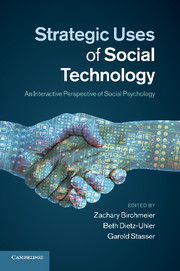Book contents
- Frontmatter
- Contents
- Figures
- Tables
- Notes on the contributors
- Acknowledgments
- 1 Introduction
- 2 A SIDE look at computer-mediated interaction
- 3 Trust, deception, and identity on the internet
- 4 An interactional approach to social influence in computer-mediated communication
- 5 Social interaction in cyberspace
- 6 Dynamics of leader emergence in online groups
- 7 Ostracism in cyberspace
- 8 Opinion-based groups
- 9 A juxtaposition of social influences
- 10 The virtual social world
- Index
- References
1 - Introduction
A social psychological analysis of computer-supported social interaction
Published online by Cambridge University Press: 07 October 2011
- Frontmatter
- Contents
- Figures
- Tables
- Notes on the contributors
- Acknowledgments
- 1 Introduction
- 2 A SIDE look at computer-mediated interaction
- 3 Trust, deception, and identity on the internet
- 4 An interactional approach to social influence in computer-mediated communication
- 5 Social interaction in cyberspace
- 6 Dynamics of leader emergence in online groups
- 7 Ostracism in cyberspace
- 8 Opinion-based groups
- 9 A juxtaposition of social influences
- 10 The virtual social world
- Index
- References
Summary
The use of computer-supported social interaction (CSI) has become a primary feature of communication among individuals, due in part to its structural features (e.g., freedom of time and geographical constraints) and psychological features (e.g., anonymity). As a consequence, many social scientists have investigated the social processes in computer-supported interactions, including online impression formation, relationship development, and group dynamics. Because individuals communicate via the use of computers in many personal, educational, and professional settings, it is important to continue and encourage the study of social processes in such environments. These studies have identified a number of influences on the behaviors (i.e., conformity, economic choices, etc.), thoughts (i.e., attitude change, impression formation, etc.), and, to a lesser degree, physiological/emotional states of people involved in computer-supported interaction.
The goal of this volume is to impose the global theoretical framework of the person-by-situation interaction (Snyder and Ickes, 1985) onto the study of computer-supported social interaction. This perspective recognizes that people are affected by the expectations and limitations of social situations, but to varying degrees. The extent that a person will respond or react to social forces has been found to depend on the levels of internal characteristics (e.g., self-esteem) that a person brings with them to the social situation. For example, social psychologists have observed that those individuals who express higher levels of self-esteem are more resistant to social pressure and as a result are less likely to conform to the influence of others (Baumeister, 1982), and are more likely to persist in the face of obstacles to their goals (Gist and Mitchell, 1992). Originally posited by Lewin (1935), reinvigorated by Mischel (1968), and then tested and validated in decades of social psychological research across a broad range of social phenomena, the explanatory rubric of social psychology can now be applied to the communication forums that have emerged in the relatively brief existence of internet technologies. Before discussing the details and benefits of the person-by-situation interaction perspective, we will review the existing theoretical frameworks that have been applied to computer-supported interactions.
- Type
- Chapter
- Information
- Strategic Uses of Social TechnologyAn Interactive Perspective of Social Psychology, pp. 1 - 15Publisher: Cambridge University PressPrint publication year: 2011



